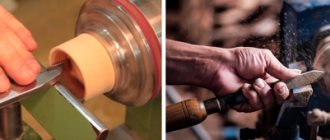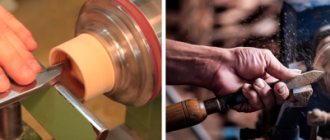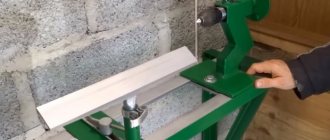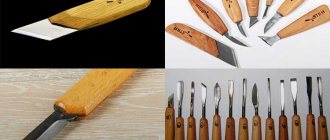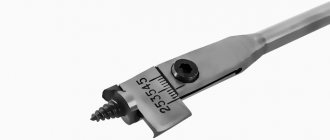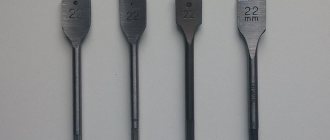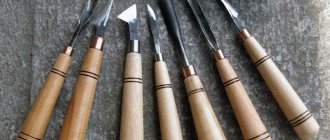The operation of lathes is impossible without the use of cutting equipment. Most often, the equipment is equipped with cutters, which allow most processing operations to be performed. Among them are boring, cutting grooves and threads, trimming, etc. A separate group of cutting tools is used for preliminary preparation of wood. The operator eliminates excess workpiece mass, allowing it to be integrated into the work area for more precise, targeted operations. But in any case, the cutter for a wood lathe must have optimal sharpening. Special equipment helps to bring the characteristics of the equipment into the proper form, but first you should understand the design of the cutter itself.
How is the cutter constructed?
The base is a metal rod, which can be divided into two parts: the working head and the shank. The cutting part has the shape of a triangle with rear and front auxiliary surfaces along which chips flow during the cutting process. Processing is performed with the main cutting edge, which craftsmen call the apex. This is the intersection of the secondary and main edges.
As for sharpening, the condition of this particular part matters. The top may be rounded or sharp. The tool also has different formats. Usually the size of the holder is taken into account - on average from 8 to 25 mm. For universal work, it is better to purchase a set of wood cutters for a lathe, which includes more than 10 pieces. The standard set includes cutters with different shapes, which allows you to make grooves, grooves, chamfer and perform shaped processing.
Wood turning cutters
- Wood turning tools are intended for manual processing of a part rotating in a machine.
- They consist of two main parts: a working part (metal) and a handle (usually wooden).
- In turn, the working part can be divided into:
- cutting (blade) - this is the part that is sharpened and interacts with the workpiece;
- body - the main part by which the turner holds the cutter with his “non-working” hand on the armrest of the machine;
- shank - a narrowed part into which the body smoothly passes. The shank is designed for attaching a handle to it.
The handle can be divided into two parts:
- the base is the large part that the turner holds in his “working” hand;
- neck - a small cylindrical part with a metal fastening ring that prevents the handle from cracking when it is pressed onto the shank of the working part.
Types of turning tools
Depending on the type of work performed, wood turning tools have different configurations; the more complex the product, the more sophisticated their design will be, which will determine the specific sharpening of the blade.
Each master can have his own special, exclusive, highly specialized turning tools designed to perform some special work.
Therefore, there is no need to study the design of each individual cutter.
For the successful work of a novice turner, two types will be enough: reyer and meisel.
Reyer - designed for rough, roughing, initial processing of the workpiece. A design feature of this type is a blade shaped like a semicircle. It is made from a thick plate or from a semicircular groove. With the help of a reyer, the wooden blank is given the approximate outline of the future product.
Reyer
Meisel - for finishing the workpiece, giving it its final shape. Also, it can be used to cut off the product from the remains of the workpiece. The shape of a meisel resembles a jamb knife (a plate with an oblique blade, sharpened on both sides at the same angle).
Meysel
With the help of a reyer and a meisel, you can easily perform turning work of medium complexity. Processing the workpiece on the outer surface. In some cases, it is possible to work with the internal surfaces of a part.
All other wood turning tools can be classified as shaped tools. Among them, the most popular types are:
- chisel-scraper - for leveling the cylindrical surface of the workpiece. The shape resembles a straight chisel with one-sided sharpening;
- comb - designed for carving and applying decorative grooves and marks;
- hook – for turning cavities in the workpiece;
- ring - has the same purpose as the hook;
- for rough processing - has a blade shape in the form of a triangle. Designed to give the workpiece a cylindrical shape. This type is the safest of all others due to the small contact area between the tool and the workpiece.
Chisel-hook Chisel-scraper Shaped cutters
Homemade wood turning tools are something of a talisman for craftsmen. Therefore, they prefer to make working tools with their own hands rather than purchase them in a regular store. Although the purchased ones fully meet their requirements, technical characteristics and safe work practices.
Homemade cutters
Making reyer and meisel yourself is not difficult. To make them with your own hands, the most suitable material would be files and rasps that have already “outlived” their usefulness.
This decommissioned tool has the required dimensions, strength, material quality, and steel grade. Using a sharpening machine, the file is given the required shape in terms of the blade and shank.
Then a machined handle with a fastening ring is stuffed. And that’s it, the tool for making wood turning products is ready.
To make wood turning tools, you can use, in addition to files and rasps, car springs or reinforcement bars as materials. They have the necessary hardness. But after making the tool with your own hands, you need to be extremely careful.
Its tests must be carried out on soft wood (linden, poplar), after which the blade must be inspected for chips and cracks.
And only after such a check can turning tools made by yourself be used when working with harder wood (birch, oak, beech).
- Video about homemade cutters
- When making cutting tools yourself, you need to remember:
- The shorter the working part, the more difficult and inconvenient it is to hold it while turning. The length of the body should provide full grip with the hand, plus support on the armrest, plus the distance from the armrest to the workpiece, plus margin for wear and sharpening. Therefore, the initial length of the working part should be at least 20 cm, but a size exceeding 40 cm will cause inconvenience in work. The optimal length should be 20 – 30 cm;
- The shorter the shank, the greater the possibility that it can be torn out of the handle. Therefore, when a cutting tool is made from files or rasps, the shanks are lengthened by 1.5 - 2 times;
- The thinner and narrower the working part of the tool, the greater the likelihood of it being damaged by the workpiece during the turning process. Therefore, at the initial stages of processing, when the workpiece does not yet have an absolute cylindrical shape and runout on the blade occurs, as well as at large diameters, when the cutting force is of great importance, it is necessary to use cutters with sufficient thickness.
- wood turning tools must have a handle no shorter than 25 cm. If it is much smaller, then during the turning process it will be difficult to hold the tool in your hands, not to mention the quality of the work performed.
Do-it-yourself sharpening of cutters
- The quality of the treated surface largely depends on the correct sharpening of the working tool.
- To do this, you will need an electric sharpening machine with a set of wheels of different grain sizes and a velvet bar for manually editing the blade.
- Video of sharpening cutters
- Each craftsman chooses the sharpening angle independently, focusing on his skill as a turner, the hardness of the wood, the quality of the working tool and the final desired appearance of the surface being processed.
- For a novice turner, the optimal sharpening angle options will be:
- for meisel - the bevel itself should be 40° relative to the axis of the working surface and 40° for each side of the blade;
- for reyer – 50° – 60°.
Over time, as the turner's skill level increases, sharpening angles can be reduced to 20° - 35°.
Ideally, in addition to a set of different styles, it is desirable to have cutters of the same type, the same size, but with different sharpening angles. This will make the turner’s work much faster and easier, and will also extend their service life, because there will be no need to constantly resharpen the blades depending on the type of wood being processed.
Blunt sharpening angles are intended for: hard wood, initial (rough) processing.
Types of turning tools
The general segment of turning tools in the main classification involves the division of equipment by purpose - for wood and metal. In this case, the first type is considered. Such models differ from metal cutters in the material of manufacture. Technologists use tool grades of steel, while metal processing is carried out with cutters made of carbon hard alloys.
Also, different types of cutters for a wood lathe differ in design. The working part can be straight, bent, drawn or curved. The choice of one or another type of cutter is determined by the wood processing method, cutting characteristics and equipment. By the way, the parameters for integrating the equipment into the fastening zone also determine differences in the design of the shank. Modern machines focus on versatility, that is, the ability to work with rectangular, round or square holders. Moreover, in this aspect, differences between cutters for metal and wood are most often not made.
Features and Specifications
Comparing solutions presented in stores from various manufacturers, for example, products from Bosch and the Skil 7720 model, you can find that they all have a similar design, in which the following components can be distinguished:
- Frame. Made of durable plastic and has a comfortable handle.
- Tool start button and speed control.
- An informative indicator that helps you find out about the tool blocking and the operating speed set at any given moment.
- A special socket allows you to quickly change and install the working tool.
It’s not hard to guess why an electric wood chisel is often called a multi-cutter. After all, this device has the capabilities of various types of working tools. For example, the equipment of one of the most popular multifunctional models among domestic consumers, Skil 7720, includes:
- steel violin blades for universal use, 35 mm wide - 5 pieces;
- steel flat cutters with a blade width of 15 mm - 2 pieces;
- steel spatulas 60 mm wide - 3 pieces;
- steel knives 60 mm wide - 5 pieces.
Having such a large set of working tools at hand, any home craftsman will be able to solve a wide variety of tasks using an electric chisel.
To get a more complete picture of the device’s capabilities, let’s return to the aforementioned multifunctional electric chisel Skil 7720 and get acquainted with its technical characteristics:
- vibration level - 12.7 m/s2;
- acoustic power level - 92 dB;
- acoustic pressure level - 81 dB;
- three operating speeds with an oscillation frequency of 6500/8500/i9500 rpm;
- platform working stroke - 2.2 mm;
- operating power indicator - 250 W;
- weight - 1.2 kg.
However, not only the above operating parameters make the Skil 7720 model a convenient and effective tool in the hands of a home craftsman. This is also facilitated by the presence of a special device in the design, with which you can quickly and without the help of additional solutions change the working tool. In this electric chisel, the manufacturer provides the possibility of additional feed of the tool forward, which also has a positive effect on the convenience and efficiency of its use.
How do you make cutters with your own hands?
As you can see, the cutter is designed quite simply, and an ordinary lathe can easily be equipped with a homemade analogue. Typically, such products are created on the basis of files and rasps. Home craftsmen only remake them to fit the format of specific turning equipment. You can also use car springs or sections of reinforcing bar as a basis. But in such cases, more effort will be required when finalizing the shape of the element.
Next, homemade cutters for a wood lathe are carefully mechanically adjusted to the required size. This is the first sharpening during which the working edge will be formed. The disadvantage of a homemade cutter is that the workpiece may have internal defects resulting from previous use. The same file, after long-term use for its original purpose, due to stress in the structure, is often endowed with voids, which reduces its working life.
Semicircular chisel
General rules for sharpening a semicircular chisel:
- In addition, further processing is carried out using coarse abrasives;
- The cutting edge must first be dull. This will smooth out the nicks;
- The final stage will be finishing;
- Next, an angle of 20-25° is selected for a semicircular and machined blade profile. Sometimes you have to divide the plane of a metal part into several parts and sharpen each one in turn.
Often the same model is used for chisels and planes. This is the wrong decision, since the instruments themselves (and, accordingly, their components), the principle of their operation and the design are completely different.
In order not to make mistakes when processing the cutting part of the tool, you need to know exactly how sharpening a chisel differs from a flat knife. To more accurately determine the differences, consider the following table:
Why is cutter sharpening important?
The need to perform this operation, at first glance, is similar to sharpening kitchen knives. A sharp blade handles cutting tasks more efficiently, requiring less effort and time. But in the case of machine tool correction, there are other technological nuances. High-quality sharpening is a preventive measure that eliminates the risk of the working head falling off during operation.
In addition, negative deformation phenomena in the form of chipping and scuffing are prevented. Obviously, the quality of the work itself on a wood lathe also improves. Correctly sharpened cutters form even grooves and grooves, not to mention shaped operations. Other factors affect the quality of work, but the sharpness of the tool tip is key to achieving optimal results.
Processing on a grindstone
Sharpening a semicircular chisel is performed in several stages. For initial processing, you will need a regular sharpener, which you can buy or make yourself, as the author of the video did. The master clearly demonstrates the sharpening process on video. First he straightens the cutting edge. After this, the chisel will become completely dull, but will have a smooth end, which needs to be sharpened in the future.
Don't forget to use safety glasses, because scale getting into your eyes can cause you a lot of unnecessary problems!
Then we watch the movie, everything is very clear there. The only thing I could add to the master is the advice to apply the chisel to the stone without any pressure to avoid overheating the metal! The fact is that for the manufacture of tools, hardened steel is used, which has high cutting properties. However, during processing on a sharpener, the metal of the chisel can become very hot and lose its performance characteristics. This will become noticeable by the tarnished colors that appear on its surface. To prevent such a result, during processing on a sharpener, the chisel must be periodically dipped in water. Don’t forget to place a container of water next to the sharpener in advance!
How to determine the end of sharpening on a sharpener?! It's very simple. Burrs should appear on the entire cutting edge, called “regrinding” in professional slang. If the edge shines somewhere and there is no sharpening, continue sharpening.
So, visual criteria for correct sharpening on a sharpener:
- 1. There should be no tarnish on the tip;
- 2. Uniform “grinding” along the entire edge.
- 3. The chamfer must be uniform, i.e. ideally repeat the radius of the stone
Sharpening equipment
Since the cutter is made on the basis of tool steel, its sharpening must be carried out on high-power equipment. For such needs, boring machines are used in different configurations. The basic structure of the design includes two base clamps and a retractable hand rest with a V-shaped stop. As an addition, adjustable hand rests can be used to expand the possibilities for securing the workpiece.
For example, if it is necessary to modify a bevel cutter for a wood lathe, then an appropriately shaped attachment may be required. In this case, an adjustable hand rest will help. But most often, universal holder models are used, designed for a wide range of standard cutters. The fixing base is usually attached under the elements that perform sharpening. The relative position of the functional sides in this part is determined by the sharpening parameters. Modern models of sharpening machines also allow you to service scraper blades, planer and chisel equipment.
Classification
Lathes are divided into:
- center ones with mechanized feed. It is possible to perform work on this equipment using hand-held cutting tools (when installing a special tool rest on the frame). An oblong piece of wood is held by a spindle and a movable tailstock. The longitudinal feed of the caliper is mechanized. These machines can be used to work with a copier. When working with short, light workpieces, the tailstock fastening may not be used. When processing the inside of a wooden part, a faceplate serves as a fastener. The moving elements in the operating mode on these lathes are the cutters moving along the piece of wood being processed and the rotating spindle.
- Lathes are used to produce parts on a flat, wide wooden base. Beautiful multi-level carvings, bas-reliefs, high reliefs - this is what can be produced on machines that work with a wide faceplate, on which the workpiece is mounted. Work is carried out only on the front part of the part. The rest of the revision will be done manually.
- round-sticks process wood, giving it a shape with a round cross-section. When working on this equipment, the workpieces do not rotate or move. The only moving parts of the machine are the heads with the cutters. There are also machines in this group for processing long products. Then they will feed the workpieces with rollers under the cutters.
Shaping wood occurs by rotating the material being processed and using a cutting tool.
Sharpening with abrasive wheels
A sharpening machine is only a technical basis for organizing the mechanical interaction between the tool being processed and the abrasive. Sharpening is carried out with discs made of electrocorundum when they rotate at a frequency of about 3000 rpm. The abrasive can be made from other materials of varying degrees of hardness, but in any case it must prevent overheating of the cutting edge.
For example, in some cases, low-frequency sharpening at 2000 rpm using a 20 cm aluminum oxide wheel is recommended. This results in a kind of “soft” sharpening effect, which is beneficial if you are using a medium-format or low-power wood lathe. How to sharpen a cutter with an abrasive disc? Experienced craftsmen recommend sharpening with slight pressure of the tool against the rotating disk. At the same time, uniformity must be ensured, which is achieved by moving the blade from side to side. If you use a machine with a retractable tool rest, then it is important to ensure that the contact patch between the abrasive and the cutter is located higher than the axis of rotation of the wheel.
Sharpening angles
The following is a list of sharpening angles for all common materials. The first fraction indicates the relief angle during roughing, the second - the relief angle during finishing. The third fraction shows the size of the front angle. The numerator indicates the angles for cutters that sharpen and bore parts, and the denominator indicates the angles for tools that plane workpieces.
- Steel (hardness less than eight hundred Megapascals) – 8/6, 12/8, 15/12.
- Steel (hardness more than eight hundred Megapascals) – 8/6, 12/8, 10/10.
- Steel (hardness more than a thousand Megapascals) – 8/6, 12/10, 10/8.
- Gray cast iron (Brinnel hardness less than two hundred and twenty) – 6/6, 10/10, 12/8.
- Gray cast iron (Brinnell hardness more than two hundred and twenty) – 6/6, 10/10, 8/5.
- Malleable cast iron – 8/8, 10/10, 8/8.
The main plan angle should be 30 - 45 degrees. The width of the chamfer depends on the cross-section of the cutting rods.
What abrasive wheels are used for sharpening turning tools? Sharpening of a tool through the holder and at an angle of 5 degrees is carried out with a wheel made of electrocorundum, having a grain size of forty - fifty, hardness CM1/2. The peripheral speed of the circle is 25 m/s.
Preparatory sharpening is carried out with products made of black silicon carbide, having a grain size of twenty-five to forty, hardness M3-SM1. The final sharpening of the cutting tool is carried out with wheels made of green silicon carbide, having a grain size of sixteen - twenty-five, hardness M3-SM1.
The parameters of grinding wheels for steel and carbide cutters are specified in the table of sharpening modes. There you can also see the circumferential torsion speeds.
Currently, final sharpening is recommended to be done using a diamond wheel. This is especially true for inserts made of hard alloys. The peripheral speed of the circle during preparatory/final sharpening should not exceed twelve to fifteen meters per second.
Finishing the characteristics of the cutter
This is a more precise operation performed on machines with diamond wheels. This sharpening method is most often used when it is necessary to remove obvious defects. For example, if a wood lathe cutter has burrs, cracks or nicks. In this case, the working process is carried out under mechanical control. That is, the tool being processed is fixed in a vice and controlled by a hydraulic or electric drive. The operator adjusts the cutter displacement parameters in accordance with the requirements for its correction parameters.
What do you need to make a homemade cutter?
To sharpen the cutting area, you will need an electric sharpener or sharpening machine. The production of some types of cutters involves sharpening using abrasive discs of different configurations.
You also need to prepare steel blanks according to the number of tools being made. The best wood cutters (chisels) for a lathe are made from R6M5 steel. Parts from old bearings, files, and taps are also suitable. You can use any suitable size product made from hard grade steel.
The tool is equipped with a wooden handle. You can buy it ready-made or make it yourself. In order to save time, it is better to buy, especially since there are handles of different sizes on sale, and they are inexpensive.
Before making wood cutters, you need to decide on the configuration and purpose: whether they will be used for finishing or rough processing, turning bowls or other purposes.
General recommendations for sharpening
Even before starting sharpening, the condition of the machine and the grinding wheel should be carefully checked. When working manually, the cutter must be supported on a handy support part, and not supported by weight. As a rule, the tool rest itself is installed 3-5 mm from the abrasive disc. To eliminate the risk of critical overheating, sharpening of cutters for a wood lathe is carried out with periodic cooling with water. This also avoids the formation of small cracks that occur under extremely high thermal loads.
How to sharpen a tool yourself?
To sharpen cutters, you can use a hand or electric tool. The second method is preferable, since sharpening with a good power tool is faster and sometimes even better.
Required Tools
To sharpen the blade you will need:
- whetstone;
- abrasive stone.
The initial rough cleaning of the blade is carried out on an abrasive stone. At the end, use a sharpening stone with fine grit.
You can also sharpen the blade on an electric sharpening machine.
Peculiarities
To straighten or sharpen the blade of the tool, you can use an electric sharpening machine. It is better to choose models with two grinding wheels.
At first, you can do rough cleaning and processing. On the second - finishing sharpening. Accordingly, the wheels should have different sizes of abrasive chips.
During operation, it is necessary to cool the blades in machine oil. Otherwise, it may overheat and lose its performance. Also, cooling in oil helps to harden the tool.
Features of sharpening
When sharpening you need to consider:
- Correct sharpening angles for each cutter.
- For beginners, it is better to take more developed, rather than sharper, sharpening angles. As your skill increases, you can decrease the angle.
- For rough cleaning and primary processing, sharpening with a more developed angle is also used.
- The initial sharpening of the blade and the formation of the cutting edge are done before working on an electric sharpening machine.
As the master masters the tool, he will come to his own sharpening angles for a particular cutter, which will be convenient to use.
Carving tools
General principles
Wood carving is a fairly popular technique for decorating various products.
As a rule, the process itself follows this scheme:
Note! Sometimes undisturbed parts of trees are decorated with carvings. In this case, a fragment is selected whose shape has maximum decorative potential.
- Then a rough leveling of the surface of the workpiece is performed, during which all defects are removed from it.
A variety of tools are used for figured carving
- After this, the surface is processed with special cutters, with the help of which a part of the wood is selected. Due to this, a decorative relief is formed.
- After the actual carving is completed, finishing is carried out - grinding the cut areas, impregnation with protective compounds, full or partial painting, varnishing, etc.
The most important tools in this process are the wood carving cutters. In addition to the skill of the carver himself, it is the quality and correct selection of the cutter that determines how clean the ornament or plot image on the wood will be.
That is why below we will look at the main types of such tools and describe where and how they are used.
Main types of incisors
To create three-dimensional images, craftsmen use a variety of types of wood cutters. In principle, if you have the skill, you can do without some of the products listed below, but to achieve the best result, it is better to collect as extensive a set as possible and use each device for its intended purpose.
Cranberries with blades of different shapes
The main types of cutters are presented in the table below:
| Variety | Application at work |
| Blunt knives |
|
| Chisels | The most common type of incisors. A typical chisel is a long rod with a cutting edge formed at the end. |
Depending on the shape of the chisel edge, there are:
- Flat – used to form straight lines and recesses. Flat chisels with a wide blade are also used for roughing to cut or chip away surface defects.
- Angle - used for cutting V-shaped grooves and notches, as well as for forming shaped elements. The smaller the angle of closure of the planes of such a chisel, the deeper the relief it forms.
- Semicircular ones are one of the most common in figured carving. The rounded shape of the end blade allows you to effectively remove wood from the solid wood, forming a recess. Small semicircular chisels are also used for texturing and scoring smooth surfaces.
- Bracket - functionally similar to semicircular, but when wood is removed, a groove is formed with clearly defined internal edges.
- Reverse (round and bracket) - used to form semicircular and rectangular protruding parts, as well as to draw parallel lines.
Wood chisels of most varieties can be produced with both straight and curved shafts. In the first case, the design of the tool allows it to be used together with a mallet, in the second, the carving is carried out solely by muscular force.
Read also: Content of precious metals in motherboards
Clukarza is usually used for finishing carvings with strong penetration, which allows the formation of a clear relief.
Generally, these tools are classified by blade shape:
- Direct.
- Semicircular.
- Oblique (distinguish between left and right incisors).
- "Swallowtails".
- Stapled.
- Reverse.
- Corner ones.
The main function of this device is to remove wood cleanly and in large volumes.
Spoon cutters of different shapes
Additional accessories
However, a master carver, in addition to chisels and knives of various shapes and sizes, also requires other tools.
The required minimum additional equipment includes:
- Wood saws (hacksaw or reciprocating saw for rough work, bow saw for finishing work).
- Jigsaws.
- Drills and rotators.
- Planers for leveling planes.
- Set of wood files (rasps).
- Mallet for processing hard wood with cutters.
- Devices for sanding wood.
Teslas of different sizes
If the master works with fairly large structures, then in addition to simple cutters he may also need figured hatchets - the so-called adzes. According to the principle of operation, they are similar to cutters (naturally, adjusted for the scale and purity of the work).
Tips for choosing
If you are planning to master the technique of wood carving with your own hands, then you need to start by selecting the appropriate tool. And here we are faced with a dilemma: really high-quality cutters are quite expensive, but if you buy a set for beginners “on the cheap,” then working with inconvenient and constantly losing sharpness devices will discourage you from engaging in this type of creativity for a long time.
Ready set of tools
The optimal solution would be to buy several good cutters, and then, if necessary, expand your toolkit. To begin with, we will need at least one medium-sized blunt knife, as well as four to five chisels: one flat, several corner and semicircular ones with different blade curves.
High-quality products from a foreign manufacturer
As for specific instances, you need to pay attention to the following features:
- The blade must be durable and well-hardened, free from rust and other defects.
- The cutting part must be securely, without play, fixed in the handle.
Note! This does not apply to knives with replaceable blades - in any case, they will have minimal play that you will have to put up with.
- Handle material: wood or durable plastic. However, the second option is still somewhat worse, since the wooden handle fits much more comfortably in a sweaty hand.
- Naturally, the handle should be even and smooth, without burrs or cracks.
- If we talk about the shape of the handle, the most common are cylindrical options (suitable for impact carving with a mallet), conical and mushroom-shaped models.
- Some manufacturers produce chisels and jambs with anatomically shaped handles equipped with finger grips, but many novice craftsmen have complaints about their convenience.
- The manufacturing company also plays an important role: today on the market you can find both domestic and foreign forms that produce products of quite decent quality. But what you should refuse are the frankly cheap Chinese and some domestic cutters: yes, you will save on the purchase, but even if you cut these products, they won’t last long.
Self-made cutter
To make a high-quality wood cutter at home, you need to follow these steps:
- Making blanks for a knife for a cutter. It is best to use an old circular wheel to create blanks. The metal must be cut using a regular grinder into small rectangular strips measuring 20x80 mm. It is worth noting that each strip can be turned into a good tool cutter in the future.
- Giving the correct shape to the main incisor. In order for the part to acquire the desired shape, it must be carefully ground. The procedure can be carried out in two ways: by forging or by sharpening on a machine. Forging is necessary to create the correct bend, and turning is necessary to obtain a good shape for the cutter knife.
- Correct sharpening of cutters for hand tools. To properly sharpen a knife, you will need a regular grinding machine with a fine-grit working wheel. The part itself must be held at an angle of 45 degrees. Depending on the total length of the cutter, the sharp part of the tool should be 20 or 35 mm. The knife itself can be sharpened not only manually, but also using specialized equipment.
- Making a handle for comfortable operation. To prevent wood carving from causing discomfort, it is necessary to make a high-quality wooden handle. Depending on personal preferences, the handle can be made manually or on a special machine. If you chose the first option, then after planing the product must be sanded with sandpaper.
- Connections between the knife and the handle. The metal cutter must be carefully inserted into the handle. To do this, you will need to drill a hole 20 or 30 mm deep in the center of the wooden handle. The blade of the cutter should be located outside, but the base itself is carefully driven into the handle. Separately, it is worth noting that for reliable fixation at the end of the metal workpiece, it is necessary to provide a special point in the form of a thin needle. At the moment of forgetting, it is advisable to use a guard made of thick fabric, so as not to dull the working blade of the knife by the end of the procedure.
- Installation of a crown for quality carving. In order to secure the manufactured knife, it is necessary to install a special metal retaining ring. A hole is cut out on a wooden handle, the contour of which corresponds to the size of the ring. Then the thread is made and the crown itself is secured. At the end of this procedure, the wooden handle should be crimped and the cutter should be securely fixed inside the product itself.
- Grinding the knife. In order for the process of wood processing to bring pleasure and good results, you need to bring the blade to readiness. For these purposes, it is best to use a small sharpening stone or simple ceramics. A little lubricant should be poured onto the surface of the sharpening product (motor oil can be used), after which the cutter can be safely sharpened perpendicularly.
After this, you are guaranteed to get a sharp tool, and if you sharpen the cutter correctly, then the wood carving will be of better quality and faster. If necessary, the cutter can always be upgraded and slightly modified.
Modern tools and wood processing technologies are directly dependent on each other
That is why, when purchasing specialized cutters, it is important to take into account not only the manufacturer’s brand and declared performance characteristics, but also the scope of their use. Standard and inexpensive kits are most suitable for minor household repairs and the creation of simple products.
Professionals will require more advanced and versatile tools that will make the process of processing wood workpieces faster and more comfortable.
And those who have already gained the necessary experience can make their own wood cutters, filling their collection with the most diverse and unexpected elements.
Knives for wood carving are a must-have accessory in the arsenal of a craftsman who makes decorative objects from natural wood.
Such tools can have different types and shapes, which directly affects the specific processing of individual parts. The most famous cutter, which is very popular among our craftsmen, is the Bogorodsk knife.
The procedure for sharpening a semicircular chisel
Sharpening a chisel with a semicircular cutter is done using a block of wood. In addition, its edge should follow the shape of the cutting edge.
To do this you will need the following:
- a piece of wood;
- a piece of polished leather.
- silicon rod;
- sandpaper (grit size from 400 to 2000 microns);
How is sharpening done?
Sharpening is performed in the following sequence:
- During the work, the chamfer is pressed at the desired angle and movements are made to the sides. The operation is carried out until the onset of acute illness;
- Then take a block, the edge of which is rounded, and on which sandpaper is fixed. During the work process, the abrasive is changed, gradually reducing its grain size;
- Finish the sharpening by polishing and straightening the edge of the leather piece.
Overview of species
The cutters differ in functionality, design nuances and other parameters.
By purpose
Here we are talking about the materials with which the cutter works.
- On wood. In markets they can be found in sets with rings, combs, reiers, hooks, and meisels. The cutters and rotation mechanisms are fastened together.
- For metal. When you need to weld or solder a plate, that’s when they talk about the optimal choice for cutters. Hard alloys and high-speed alloys are used more often in this case. Installation of such cutters is possible not only on lathes, but also on slotting, planing, special-purpose and others.
This classification is small, the choice here will not be difficult.
By design
These are solid cutters in which the shaft and head are articulated by one system. Or is it a tool with welded plates, they are very firmly connected to the head. If the soldering of the plates was carried out without technical precision, cracks may subsequently form on the working surface. Such cutters are widely used because they are suitable for a wide variety of machines.
By type of processing
Here the cutters are divided into fine and semi-finish. For finishing machines, the feed rate is low; material with a small thickness is removed from the blank. Most often, such tools are represented by a through cutter. Semi-finish ones are very similar to the previous version, but they are weaker in characteristics than finishing ones. But they can be used for the same tasks.
By type of installation
Tangential cutters are a tool that is installed at a certain angle, any angle except the straight one. This is measured relative to the axis of the surface that is undergoing the operation. And the tool is distinguished by a complex fastening scheme for internal turning.
The radial cutter is distinguished by fixing an exclusively right angle on the surface that is being processed. A popular option for industrial purposes. And the radial version has a big advantage - it is a simplified fastening system.
By feed type
Here everything is even simpler: left-handed cutters are tools with the right-hand side of the cut, and it is towards it that the metal being processed is turned. The right incisors have a cutting part on the left; the metal surface for processing is turned onto it.
By fastening the cutting part relative to the rod
And this characteristic presents 4 types of incisors. The bent ones are distinguished by a special curved line, a characteristic feature of the projection axis of the upper position. And lateral localization ensures the straightness of the lines. Straight incisors are those whose axis of projection maintains an even line, both from above and from the side.
In retracted incisors, the head and shaft are different in size, the head will be smaller. It is attached to the incisal axis. The part is characterized by some displacement relative to the axis of the cutters, in any direction. Well, curved incisors in the upper localization are connected to the projection axis by a straight line, while the lateral projection is connected to a curved line.
By processing method
And there are many varieties here.
- Trimming. If it is a machine with cross-feed workpieces, the tool is easily connected to the equipment. These are either the edges of different surfaces, or stepped elements.
- Walkthroughs. Functional for metalworking with cross and longitudinal feed equipment. This is relevant if trimming concerns the ends, cylindrical and cone-shaped workpieces.
- Boring. Needed for through and blind holes, for recesses and recesses.
- Round. Here the shape determined the name.
- Threaded. External and internal threads are formed, with a trapezoidal cross-section, as well as round and rectangular. The products themselves can be smooth, round, or convex.
Tools and materials for sharpening
To sharpen a chisel you will need the following tools and materials:
- abrasives in sheet form;
- horizontal and vertical machines;
- polishing cloth or felt.
- sharpener;
- sandpaper on a block;
- special clamps and frames;
In addition, frames with angle adjustment will be useful (it is recommended to use the factory version) and a device with which you can create a distortion on the bevel using special wedges (you can use a homemade device).
In addition, chisels, chisels, knives and planes are sharpened with a sharpener.
The same tools and materials can be used if it is necessary to process the knife in a plane.
Using a wheel and sandpaper
Blades are sharpened using grinding wheels and sandpaper. During the manufacturing process, it is necessary to use different types of wheels of medium and low hardness.
Sandpaper is used in the process of “trying on” the ideal shapes of a metal part. This material is used exclusively by hand.

